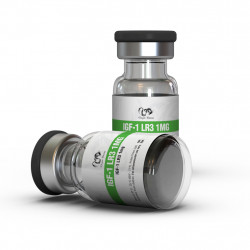


In 1992 Long(R3)-IGF-1 was introduced as a modified version of IGF1 with the aim to prolong the peptides life and improve its ability to resist proteins for better effectiveness, in promoting muscle growth through its anabolic and catabolic properties. These modifications allow Long(R3)-IGF-1 to have 2.5 to 3 times the potency of regular IGF-1, making it a popular choice in muscle-building circles
Llewellyn, W. (2017). William Llewellyn's Anabolics.
United States: Molecular Nutrition, LLC.
Disclaimer: Information provided it this page is for general information only and does not substitute for professional medical advice.
For detailed information about IGF-1 LR3 by Dragon Pharma, consult with your doctor or healthcare professional.


Llewellyn, W. (2017). William Llewellyn's Anabolics.
United States: Molecular Nutrition, LLC.

Llewellyn, W. (2017). William Llewellyn's Anabolics.
United States: Molecular Nutrition, LLC.

Llewellyn, W. (2017). William Llewellyn's Anabolics.
United States: Molecular Nutrition, LLC.